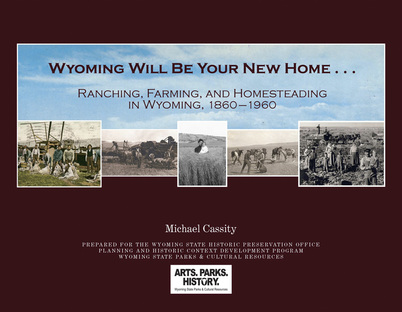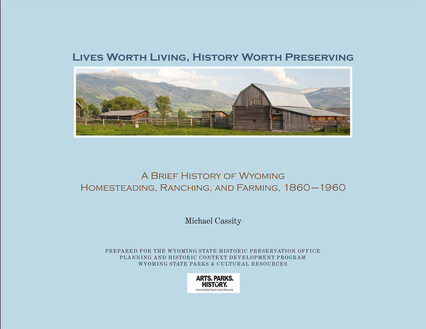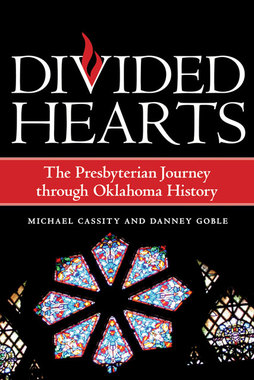Books by Michael Cassity
Fort Laramie's People: An Exploration
in Historical Context

This book-length study is an examination not of military operations and deployments at Fort Laramie, but of the contours of social change there. In the post's brief (four decades) history, it both witnessed and shaped the transformation of Wyoming, effectively bridging the social orders of the native tribes and the fur trade at one end and the making of modern Wyoming--and its social tensions--at the other end. You can download a copy here by clicking on the cover image to the left.
Building Up Wyoming: Depression-Era Federal Projects in Wyoming, 1929-1943

This study is now available as a PDF for free download on this website at this page and also at the Wyoming State Historic Preservation Office webpage. It is available in paperback from the Museum Store in the Wyoming State Museum. (Contact http://wyomuseum.state.wy.us/Contact/Contact.aspx?id=beth.miller or call (307) 777-5320.) The book examines the projects undertaken by the federal government to combat the Great Depression, during both the Herbert Hoover and Franklin Roosevelt administrations. While it is common to view the work relief programs as frozen in time, this study explores the work programs as evolving, changing efforts. When we look at the multitude of courthouses, post offices, dams, schools, roads, sewer systems, airports, libraries, irrigation projects, works of art, and many other physical remnants of those projects, we are seeing a complex array of efforts that not only built up the physical infrastructure of the nation but also transformed it. This book shows how that transformation took place in Wyoming.
The Wind Whispers Their Names:
A Brief History of Depression-Era Federal Projects in Wyoming, 1929-1943

Click on the picture of the booklet to download it. This booklet addresses some of the core issues in the longer study (Building Up Wyoming), but in its brevity it also provides some shift in focus.
Wyoming Will Be Your New Home: . . .:
Ranching, Farming, and Homesteading in Wyoming,
1860-1960

Wyoming Will Be Your New Home . . .: Ranching, Farming, and Homesteading in Wyoming, 1860-1960 (Cheyenne: Wyoming State Historic Preservation Office, 2011). Available online for free PDF download and is available from the Wyoming State Historic Preservation as a free PDF download at http://wyoshpo.state.wy.us/homestead/pdf/historic_context_study_011311.pdf. Additional materials related to the study are available at http://wyoshpo.state.wy.us/homestead/index.html. Paperback copies of the study can be purchased from the Wyoming State Museum Store. Contact http://wyomuseum.state.wy.us/Contact/Contact.aspx?id=beth.miller or call (307) 777-5320.
”This is a superb piece of work. Wonderfully written and exhaustively researched, this context should serve as the model for all of the contexts now being prepared. I think the context makes several major contributions to our understanding of Wyoming agricultural history. It is the first book length study of Wyoming history that is by a social historian and therefore places as much emphasis on the experiences of the people living on the ranches and farms, as on government policies. Though the topic is limited it offers for the first time ground breaking interpretations of not only Wyoming agricultural history but of Wyoming history.”
David Kathka, former Wyoming State Historian and State Historic Preservation Officer
"Cassity deserves high praise for this book . . . . The combination of a carefully defined scope of study, a well-organized narrative, and meticulous research makes this book an outstanding effort. Cassity's skilful integration of primary sources from Wyoming archives (letters, WPA oral interviews, diaries) adds a personal element to what could have been an impersonal state history."
Renée M. Laegreid
Western Historical Quarterly
" . . . This book offers an engaging and encyclopedic narrative of ranching, farming, and homesteading that will be useful to students of agricultural history, environmental history, the American West, land policy, economics, and demographics in US history writ large. In short, the book connects the development of Wyoming agriculture to the larger historical context.
. . . The book fulfills its goal of providing a research tool for Wyoming historians, but it also functions as a useful survey of US agricultural history from 1860–1960 that could serve researchers working in other fields."
Todd M. Kerstetter
Agricultural History
Lives Worth Living, History Worth Preserving:
A Brief History of Wyoming Homesteading, Ranching, and Farming, 1860-1960

Lives Worth Living, History Worth Preserving: A Brief History of Wyoming Homesteading, Ranching, and Farming, 1860-1960 (Cheyenne, Wyoming: Wyoming State Historic Preservation Office, 2010). This can be downloaded as a PDF download by clicking on the image to the left. This is a condensed version of the above study, Wyoming Will Be Your New Home.
Divided Hearts: The Presbyterian Journey through Oklahoma History

Divided Hearts: The Presbyterian Journey through Oklahoma History (Norman: University of Oklahoma Press, 2009). With Danney Goble. Available at:
http://www.amazon.com/Divided-Hearts-Presbyterian-Journey-Oklahoma/dp/0806138483/ref=pd_rhf_p_t_4
“Divided Hearts is a thorough account of the trials and tribulations of an important Protestant denomination in Oklahoma. The authors tell the tale of Oklahoma Presbyterians with exceptional fair mindedness and narrative skill. Indeed, this book is a model of how a state denominational history should be written.”
Ferenc Szasz
University of New Mexico
“This informative book will be a valuable resource both for churches and for historians. By providing a balanced and unsentimental view of its subject, it sets a high standard for denominational histories. Strongly recommended.”
Bonnie Sue Lewis
Author, Creating Christian Indians: Native Clergy in the Presbyterian Church
http://www.amazon.com/Divided-Hearts-Presbyterian-Journey-Oklahoma/dp/0806138483/ref=pd_rhf_p_t_4
“Divided Hearts is a thorough account of the trials and tribulations of an important Protestant denomination in Oklahoma. The authors tell the tale of Oklahoma Presbyterians with exceptional fair mindedness and narrative skill. Indeed, this book is a model of how a state denominational history should be written.”
Ferenc Szasz
University of New Mexico
“This informative book will be a valuable resource both for churches and for historians. By providing a balanced and unsentimental view of its subject, it sets a high standard for denominational histories. Strongly recommended.”
Bonnie Sue Lewis
Author, Creating Christian Indians: Native Clergy in the Presbyterian Church
Defending a Way of Life: An American Community in the Nineteenth Century

http://www.amazon.com/Defending-Way-Life-Community-Nineteenth/dp/0887068693/ref=sr_1_1?ie=UTF8&s=books&qid=1254776225&sr=8-1
“In his remarkable new book Michael Cassity explores the history of Sedalia and the surrounding countryside of Pettis County. . . . He has boldly and with considerable success offered a theory that tries to make sense of small-town America. In the case of Sedalia, we see a place caught between two worlds, its citizens embracing the new order only after a wearying struggle to save the old. Such people possessed many strengths and weaknesses. But one thing was clear: few were expectant capitalists hellbent for the Great Barbecue.”
Barton Shaw
Journal of Southern History
“It is no secret that the field of American social history is presently in a quagmire. While some subspecialties (e.g., women’s history) are developing fresh approaches, others (e.g. labor history) are not. Michael Cassity’s Defending a Way of Life: An American Community in the Nineteenth Century is a marvelously refreshing attempt to free the field from all these problems and to suggest a new agenda for social historians. The various elements of this book weave together so well that it is hard to pinpoint which features are the most important. It does so through a warm and generous exploration of the many ways human beings preserve a sense of pride amid the pains caused by external forces which change their internal lives. Its style is insightful, eloquent and impassioned.”
David Thelen, Editor
Journal of American History
“Sedalia has hitherto been known to outsiders mainly for the bucolic aura of the Missouri State Fair. In Michael Cassity’s hands it becomes one locus of the wrenching transition from traditional community to modern commercial-industrial society. . . . From his own impassioned account, all the modern world may indeed be a Sedalia.”
Rowland Berthoff
Washington University
“. . . Defending a Way of Life is a valuable contribution to the body of work on the impact of capitalism and industrialization on the United States in the nineteenth century, which labor and social historians will want to consult. Cassity’s research makes this a model of careful and thoughtful scholarship.”
Mark J. Stern
Journal of American History
"Cassity depicts the independent lives, the strength of the bonds of community and mutuality, the fundaments of equality, and the ecological balance of multicrop agriculture in terms worthy of a Rousseau celebrating the noble savage or a Jefferson prizing the yeoman farmer. Only the more romantic and nostalgic passages of Peter Laslett's The World We Have Lost will stand comparison to this beautifully crafted paean to frontier life in a preindustrial age before market relations intruded."
Gregory R. Zieren
The Annals of Iowa
“In his remarkable new book Michael Cassity explores the history of Sedalia and the surrounding countryside of Pettis County. . . . He has boldly and with considerable success offered a theory that tries to make sense of small-town America. In the case of Sedalia, we see a place caught between two worlds, its citizens embracing the new order only after a wearying struggle to save the old. Such people possessed many strengths and weaknesses. But one thing was clear: few were expectant capitalists hellbent for the Great Barbecue.”
Barton Shaw
Journal of Southern History
“It is no secret that the field of American social history is presently in a quagmire. While some subspecialties (e.g., women’s history) are developing fresh approaches, others (e.g. labor history) are not. Michael Cassity’s Defending a Way of Life: An American Community in the Nineteenth Century is a marvelously refreshing attempt to free the field from all these problems and to suggest a new agenda for social historians. The various elements of this book weave together so well that it is hard to pinpoint which features are the most important. It does so through a warm and generous exploration of the many ways human beings preserve a sense of pride amid the pains caused by external forces which change their internal lives. Its style is insightful, eloquent and impassioned.”
David Thelen, Editor
Journal of American History
“Sedalia has hitherto been known to outsiders mainly for the bucolic aura of the Missouri State Fair. In Michael Cassity’s hands it becomes one locus of the wrenching transition from traditional community to modern commercial-industrial society. . . . From his own impassioned account, all the modern world may indeed be a Sedalia.”
Rowland Berthoff
Washington University
“. . . Defending a Way of Life is a valuable contribution to the body of work on the impact of capitalism and industrialization on the United States in the nineteenth century, which labor and social historians will want to consult. Cassity’s research makes this a model of careful and thoughtful scholarship.”
Mark J. Stern
Journal of American History
"Cassity depicts the independent lives, the strength of the bonds of community and mutuality, the fundaments of equality, and the ecological balance of multicrop agriculture in terms worthy of a Rousseau celebrating the noble savage or a Jefferson prizing the yeoman farmer. Only the more romantic and nostalgic passages of Peter Laslett's The World We Have Lost will stand comparison to this beautifully crafted paean to frontier life in a preindustrial age before market relations intruded."
Gregory R. Zieren
The Annals of Iowa
Legacy of Fear: American Race Relations to 1900

Legacy of Fear: American Race Relations to 1900 (Westport, Connecticut: Greenwood Press, 1983). This book is available at: http://www.greenwood.com/catalog/CLF%252f.aspx
“An ambitious attempt to discern, a posteriori and existentially, a dynamic for racism. Cassity provides a provocative essay followed by a guided tour of carefully selected contemporaneous documents.”
Choice
“Cassity’s Legacy of Fear has a twofold importance: (1) it establishes both a social and historical context for American race relations, and it makes this context intelligible in the broader patterns of social organization and change; and (2) it provides an extraordinary range of source documents that should prove invaluable to students of American race relations.”
Frances Cordasco
The Annals of the American Academy
“An ambitious attempt to discern, a posteriori and existentially, a dynamic for racism. Cassity provides a provocative essay followed by a guided tour of carefully selected contemporaneous documents.”
Choice
“Cassity’s Legacy of Fear has a twofold importance: (1) it establishes both a social and historical context for American race relations, and it makes this context intelligible in the broader patterns of social organization and change; and (2) it provides an extraordinary range of source documents that should prove invaluable to students of American race relations.”
Frances Cordasco
The Annals of the American Academy
Chains of Fear: American Race Relations Since Reconstruction

Chains of Fear: American Race Relations Since Reconstruction (Westport, Connecticut: Greenwood Press, 1984). This book is available at: http://www.greenwood.com/catalog/CRR%252f.aspx
“This work consists of 60 documents illuminating American race relations since 1860.... Each document is ably prefaced by the editor. There is also an essay introducing the book as a whole in the form of an invitation to the reader to search for the roots of American race prejudice.... The essay also emphasizes that the American people shape race relations independently of the courses urged by their leaders. Appropriately, the sources chosen by Cassity are `grass-roots sources' and not the words of national leaders. An excellent collection of material with appropriate words of editorial guidance”
S. Cresswell
Choice
“This work consists of 60 documents illuminating American race relations since 1860.... Each document is ably prefaced by the editor. There is also an essay introducing the book as a whole in the form of an invitation to the reader to search for the roots of American race prejudice.... The essay also emphasizes that the American people shape race relations independently of the courses urged by their leaders. Appropriately, the sources chosen by Cassity are `grass-roots sources' and not the words of national leaders. An excellent collection of material with appropriate words of editorial guidance”
S. Cresswell
Choice
